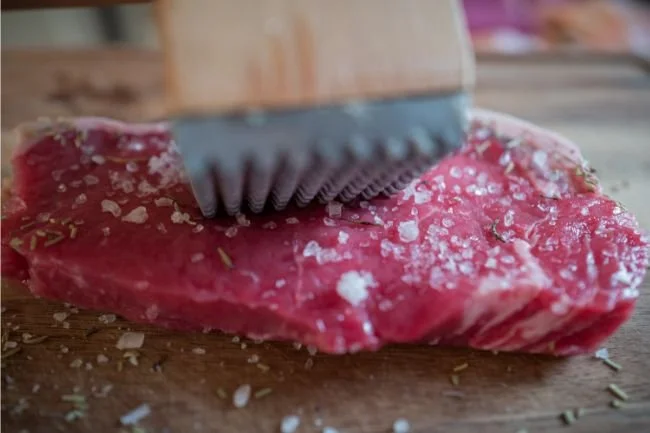What Meat Tenderizer Do Chefs Use for Perfect BBQ Flavor?
Written By James Morgan
When diving into the world of barbecue, one of the most common questions is: What meat tenderizer do chefs use? This question is crucial for barbecue enthusiasts because transforming a tough piece of meat into a succulent, tender dish requires secrets masters know well. Fortunately, were here to unpack these secrets and provide you with insights that will elevate your barbecue game to the next level.

The Importance of Meat Tenderizing in Barbecue
Barbecue lovers are always on the hunt for that perfect, melt-in-your-mouth texture. The key to achieving this is in using an effective meat tenderizer. But not all tenderizers are created equal. Understanding what the pros use can drastically change the results of your grilling sessions.
Why Tenderizing is Crucial
Meat tenderizing is essential because it breaks down the muscle fibers and connective tissues in the meat, making it softer and easier to chew. This process also allows marinades to penetrate deeper, enhancing the flavor profile of your dish.
One of our detailed articles elaborates on this concept. How a Meat Tenderizer Works explains all the intricate details of the tenderizing process.

Mechanical Tenderizers: A Chef's Favorite
Mechanical tenderizers are widely used in professional kitchens. These devices range from simple hand-held mallets to intricate needle and blade machines. The underlying principle remains the same: physically breaking the muscle fibers to make the meat tender.
Mallets and Pounders
The most traditional tenderizing tools are mallets and pounders. Often made of wood or metal, these tools are equipped with textured faces designed to break down the fibers in the meat. Many chefs prefer these because they offer control over the tenderizing process.
For a more in-depth discussion about the varieties and functions of meat tenderizers, check out Plain Meat Tenderizer Information.
Needle and Blade Tenderizers
Needle and blade tenderizers are more advanced. These tools use multiple blades or needles to create small cuts in the meat, enhancing the breakdown of muscle fibers and improving the absorption of marinades.
These methods are particularly effective for tougher cuts such as flank steak or brisket. More insights into how these tenderizers function can be found at Tenderizer Breakdown Article.

Chemical Tenderizers: The Science Behind Tender Meat
Another popular method is the use of chemical tenderizers. These often come in the form of powders or marinades containing enzymes like papain (from papayas) and bromelain (from pineapples). These enzymes break down the protein structures in the meat, making it tender.
Enzyme-Based Powders
Papain and bromelain are the most commonly used enzymes in commercial meat tenderizers. These enzymes work by breaking down the meat fibers and collagen, leading to a more tender texture. Many chefs rely on these tenderizers for their convenience and effectiveness.
Marinades with Tenderizing Properties
Marinades not only add flavor but can also contain enzymes to tenderize meat. Ingredients such as yogurt, buttermilk, and even certain fruits can provide the dual benefit of tenderizing and flavoring the meat.

Natural Tenderizing Methods
For those looking for more natural methods, there are plenty of alternatives. Ingredients like vinegar, lemon juice, and even beer can be used to tenderize meat naturally. These methods often impart a unique flavor while making the meat tender.
Using Acids for Tenderizing
Acids break down protein structures, making the meat less tough. Vinegar and citrus juices are excellent options for this. They not only tenderize the meat but also add a zesty flavor.
If youre curious about making your own tenderizer paste, our article How to Make Meat Tenderizer Paste provides a step-by-step guide.
Dairy Products as Tenderizers
Dairy products like buttermilk and yogurt contain mild acids and enzymes that help in breaking down the meat fibers. These are often used in Indian and Middle Eastern cuisines to both marinate and tenderize meat over several hours.
Temperature and Time: The Key to Tender Meat
Beyond mechanical and chemical methods, chefs also use temperature and time to tenderize meat. Slow cooking at low temperatures allows collagen to break down into gelatin gradually, resulting in a more tender and juicy piece of meat.
Low and Slow Cooking Methods
Devices like slow cookers, sous-vide machines, and even ovens set to a low temperature can make even the toughest cuts of meat tender. This method requires patience but is incredibly effective.
For example, Serious Eats Tenderizing Methods provides extensive advice on low slow cooking techniques.
Resting and Aging
Resting meat after cooking and proper aging before cooking are crucial steps. Resting allows the juices to redistribute throughout the meat, and aging breaks down muscle fibers, making the meat naturally tender over time.
Frequently Asked Questions
1. Why is tenderizing meat important?
Tenderizing meat breaks down fibers and connective tissues, making it softer, easier to chew, and better at absorbing marinades. This process is essential for achieving that melt-in-your-mouth texture barbecue enthusiasts crave.
2. Can tenderizing ruin the meat?
Over-tenderizing, especially with chemical methods, can make the meat mushy. Hence, following instructions and recommendations is crucial to avoid this.
3. Are natural tenderizers as effective as mechanical or chemical ones?
While natural tenderizers can be effective, they often take longer and may not be as consistent as mechanical or chemical methods. However, they can impart unique flavors that other methods cannot.
As an Amazon Associate, I earn from qualifying purchases.



